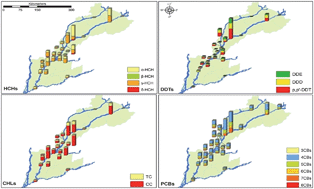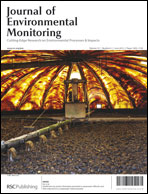Distribution and risk assessment of organochlorine contaminants in surface water from River Chenab, Pakistan†
Abstract
Concentrations in surface waters (including particulate phase) of the River Chenab ranged from 27–1100 ng L−1 and 25–1200 ng L−1 for OCPs and 7.7–110 ng L−1 and 13–99 ng L−1 for PCBs during summer and winter, respectively from 2007–2009. DDTs exhibited the highest concentration, followed by HCHs > chlordane > ∑24PCBs > ∑other OCPs. Different indicative ratios for organochlorines suggest that current use, long range transport and also past application of these chemicals contribute to the total burden. Statistical analysis highlighted agricultural and industrial activities and municipal waste disposal as main sources of OCPs and PCBs in the riverine ecosystem of the River Chenab. Risk Quotients (RQCCCs) > 10 for DDTs and PCBs levels in collected water samples from the River Chenab suggest that risk from DDTs and PCBs is moderate to severe and fluxes calculated for OCPs and PCBs from the River Chenab to the Indus River were 7.5 tons per year and 1.0 tons per year, respectively.


 Please wait while we load your content...
Please wait while we load your content...